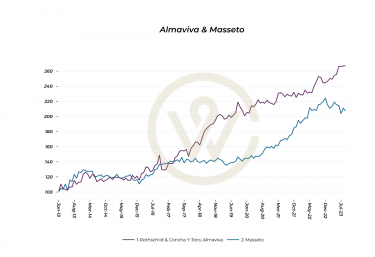Key trends that shaped the fine wine market in Q3
The following article is an extract from our Q3 Fine Wine Investment report, which will be published next week.
- Ongoing inflation and interest rate hikes led to increased volatility in mainstream markets.
- The fine wine market in Q3 was a buyer’s market for two main reasons: availability of stock and falling prices creating value.
- Two of the best value La Place releases were Almaviva 2021 and Masseto 2020.
High interest rates rattle global markets
Mainstream markets experienced a turbulent third quarter, mainly due to a marked rise in borrowing costs coupled with a substantial increase of nearly 30% in oil prices. As a major input in several industries, rising prices for crude oil led to overall increase in production costs, impacting profit margins and, ultimately, reducing stock prices. These developments created a challenging landscape for stocks and bonds, with investors opting for more liquid assets like cash that tends to be a safer short-term bet. This inclination towards liquid assets illustrated the unresolved struggle between the Federal Reserve and inflation, leaving investors navigating a path marked by heightened risk and uncertainty.
Fine wine’s downturn slows
Fine wine prices fell in Q3, but their declines gradually became smaller. For instance, the Liv-ex 100 index recorded dips of 3.1% in July, 1.3% in August and 0.1% in September, showing humble signs of recovery. The broader Liv-ex 1000 index dipped 3.9% in Q3. Italian wine fared well, thanks to strong performance from Tuscany and Piedmont, as well as older Bordeaux vintages which experienced slight rebounds. Global trading activity increased suggesting that interest is there for well-priced stock.
A buyer’s market
The fine wine market in Q3 was a buyer’s market for two main reasons: availability of stock and falling prices creating value. This was particularly noticeable in regions like Champagne. Some of the top and most desirable brands, which have an impressive mid- to long-term performance saw small declines in Q3. Buyers took advantage of this opportunity and demand increased. Such is the case with Dom Pérignon 2013, which has fallen 7.1% in value since its release in January but has been the most traded wine this year. The brand’s overall trajectory is upwards, with Dom Pérignon prices rising 64% on average in the last five years, and 133% over the last decade.
Assessing the La Place de Bordeaux campaign
Over 110 fine wines were released through La Place de Bordeaux this September. The overall pricing strategy bore similarities to Bordeaux En Primeur earlier this year: price increases that failed to take the current market environment into account. Some critics expressed the opinion that there weren’t ‘as many hits as usual’. Two wines that stood out as good value were Almaviva 2021 and Masseto 2020; the latter immediately generated trading activity above its release price.
Over the last decade, Almaviva prices have risen on average 167%, while Masseto is up 107%.

Stay tuned – our Q3 Fine Wine Investment report will be published next week. The report contains further analysis on the best-performing and most in-demand wines, and Q4 investment outlook.
Three reasons why the Brexit deal will prevent customers from paying more for their wine.
Ever since the UK voted to leave the European Union in 2016, trade talks and negotiations between the two sides had been full of uncertainty, posturing and brinkmanship which at times made it feel like a deal was unobtainable. So, the news that a trade deal – now ratified by the UK Parliament - had been struck on Christmas Eve last year was met with welcome relief across all industry sectors on both sides of the Channel and especially by those looking to invest in wine.
1. The costly VI-1 import documentation for UK and EU wines is no longer going to be introduced in July as previously planned. Taking its place will be a straightforward Wine Import Certificate which asks for basic producer and product information. This means far less admin and fees for wine importers, which in turn means no extra costs will be passed on to customers.
2. Crucially, wines will not have to undergo lab assessment for the new Wine Import Certificate. Submitting wines for lab analysis would have caused backlogs of wines which would have created frustrating shipment delays.
3. While UK wine importers are going to have to get to grips with new processes and forms over the coming months, this is just part of the anticipated bedding-in period which will become second nature as time goes on and as new processes are established.
With the previous uncertainty around Brexit having disappeared with the end of the transition period and with 2021 looking to mirror previous years of healthy returns for fine wine, contact us to speak to one of our advisors about creating your portfolio to invest in wine.
Sign up to our newsletter to keep in the know about market developments
Subscribe to our newsletter
T: UK +44 207 060 7500T: US +1 310 310 7610 | hello@winecap.com
Registered Office: WineCap Limited, Salisbury House, London, United Kingdom, EC2M 5SQ
WineCap Limited | Company No. 08480079 | VAT No. GB174 8533 80 | AWRS No. XCAW00000119418 | WOWGR: GBOG174853300
Copyright © 2025 WineCap Limited
T: UK +44 207 060 7500 | T: US +1 310 310 7610 | hello@winecap.com
Registered Office: WineCap Limited, Salisbury House, London, United Kingdom, EC2M 5SQ
WineCap Limited | Company No. 08480079 | VAT No. GB174 8533 80 | AWRS No. XCAW00000119418 | WOWGR: GBOG174853300
Copyright © 2025 WineCap Limited